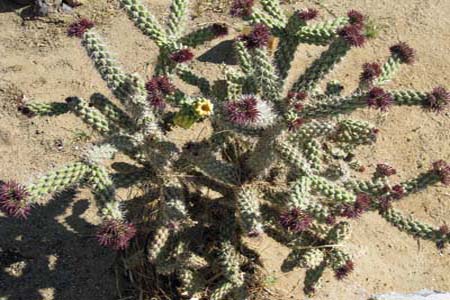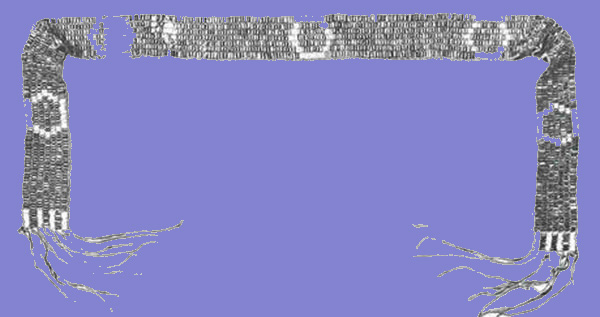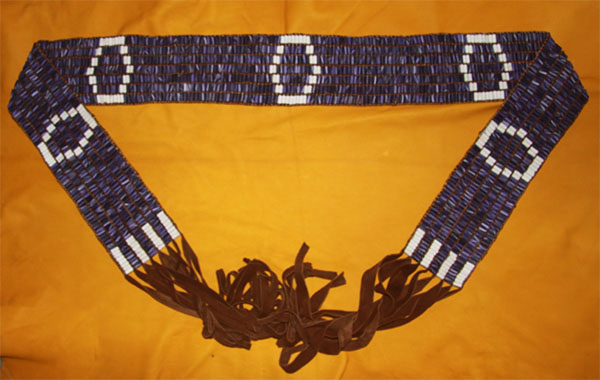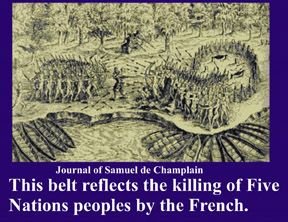 |
 |
Photographs (left to right): Chain Cholla, Mohave Desert, California; Black Swallowtail, Rush, NY; Mono Lake, California
Wampum Belt Archive
Champlain Belt

Original

Reproduction (R. D. Hamell)
Original Size: |
Length: 39.6 inches. Width: 2 inches. Rows: 7 wide. |
Reproduction: |
Length: 52.0 inches. Width: 3.25 inches. Length with fringe: 76.0 inches. |
Beads: |
Rows: 287 by 7 beads wide. Total beads: 2,009. |
Materials: |
Warp: leather. Weave: artificial sinew. |
Description:
This belt is practically a duplicate of the Eli S. Parker Belt (37434) in the State Museum collection. Both belts are woven with purple-beaded backgrounds carrying five white hexagons equally spaced along its length. At each end, for the length of an inch, are alternating rows of white and purple beads, and the only apparent difference between this and the Parker Belt is that the latter has three white stripes at each end, while this one carries four. The "reading," as given by Daniel and. Thomas La Forte (Beauchamp, '01, p. 419) at Onondaga Castle, July 19 and August 1, 1898, is as follows: "Represents a sorrow meeting of the Five Nations. If a misfortune happen: if little boys and girls were taken and one killed-to consider what should be done for remedy that misfortunes tooth for a tooth, an eye for an eye. This belt is used when meeting of that kind is called." A label on this belt states that it commemorates the excursion of Samuel Champlain into the country of the Iroquois in 1609. This belt is similar to the Invitation to the Confederacy belt and perhaps may be the same.


Bardeau stated (2011) "This record belt is thought to commemorate Samuel Champlain's arrival into Hodinöhsön:ni´ country in 1609. Champlain introduced firearms to Turtle Island.
It is said that its effects changed the warrior's tactics from hand-to-hand combat in open fields to guerrilla style warfare. This belt reflects the Canadian French killing of Five Nations peoples. A reading of the belt in 1898 at Onondaga is said to represent a 'sorrow meeting of the Five Nations'.
Stolle, Nickolaus (2016). Backed with linen 1956. Bequest of Mrs. John Boyd Thacher in 1927, purchased it from husband of General Henry Carrington in 1897, who bought it from Thomas Webster, an Onondaga in 1891.
Reference:
Bardeau, Phyllis Eileen Wms. 2011. Definitive Seneca: It's In The Word. Jaré Cardinal, editor. Seneca-Iroquois Museum Publisher, Salamanca, New York, 443pp .
Clarke, Noah T. 1931 New York State Museum Bulletin No. 288.
Stolle, Nickolaus. 2016. Talking Beads: The history of wampum as a value and knowledge bearer, from its very first beginnings until today. Hamburg, Germany. ISSN 1437-7837
 |
 |
 |
 |
 |
 |
 |
 |
|---|